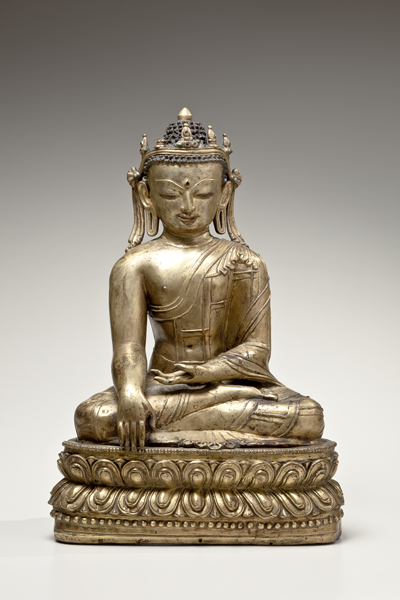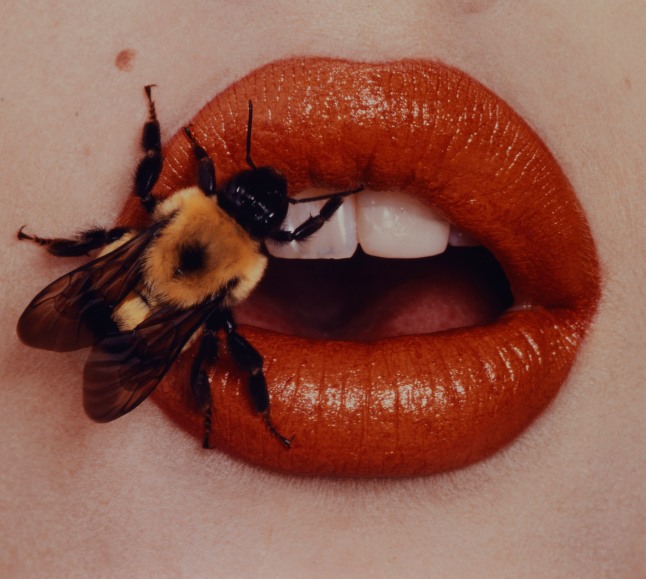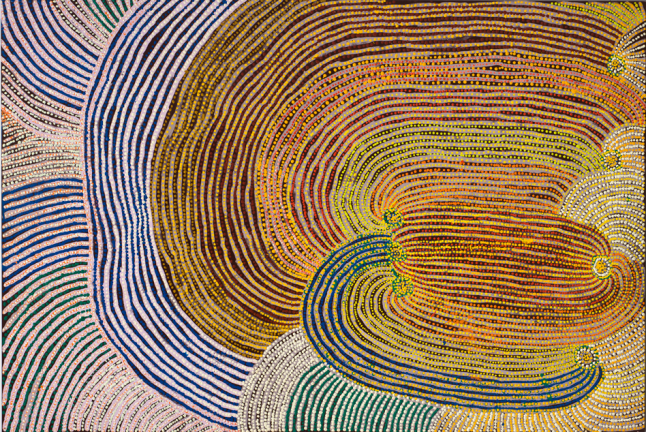Frist Center Exhibition Schedule Features Buddhist Art; Contemporary American Art from the Crystal Bridges Museum; Irving Penn Retrospective; Soundsuits and Installations by Contemporary Artist Nick Cave; and More
From a 15th-century Tibetan crowned Buddha statue to Nick Cave‘s mesmerizing Soundsuits, the Frist Center for the Visual Arts‘ 2017 exhibition lineup offers an outstanding range of artistic perspectives. (Dates in the schedule below are subject to change.)
A museum with a reputation for excellence and scholarship (accredited by the American Alliance of Museums), the Frist Center for the Visual Arts is a nonprofit art exhibition center dedicated to presenting and originating high-quality exhibitions with related educational programs and community outreach activities. Located at 919 Broadway in downtown Nashville, Tenn., the Frist Center offers the finest visual art from local, regional, national, and international sources in a program of changing exhibitions that inspire people through art to look at their world in new ways. The 2017 Schedule includes the following:

Secrets of Buddhist Art: Tibet, Japan, and Korea; February 10–May 7, 2017: Crowned Buddha, Tibet, 15th–16th centuries. Mercury gilding, copper alloy, and turquoise. Newark Museum, Purchase 1920 Shelton Collection, 20.454
Secrets of Buddhist Art: Tibet, Japan, and Korea
February 10–May 7, 2017
Ingram Gallery
Tibet, Japan, and Korea all practice forms of esoteric or “secret” Buddhism that are explained only to initiates. The Vajrayana branch of Buddhism utilizes works of art that reveal a complex array of both human and divine figures. Organized exclusively for the Frist Center, the exhibition showcases approximately 100 works from the Newark Museum‘s renowned collection that will introduce a general audience to the stunning aesthetics of Buddhist art and provide a basic understanding of these objects’ function within Buddhist practice. As part of an accompanying educational gallery and program, visitors will have the opportunity to watch Tibetan-Buddhist monks create a sand mandala painting. The painting will be on view in the galleries until the closing weekend of the exhibition, when it will be ceremonially destroyed.
This exhibition was organized by the Newark Museum.
Claire Morgan
February 10–May 7, 2017
Gordon Contemporary Artists Project Gallery
Born in Belfast, Northern Ireland and now living in England, Claire Morgan uses organic materials and taxidermy to create intricate sculptures, hanging installations, and works on paper that explore the impermanence, complexity, and fragility of life forms. Her interest in natural processes and the physicality of animals is seen through her works that capture both the elegance and beauty of life, but also the senselessness and shock of death. Emanating melancholy, Morgan’s works of life suspended in action portend a future of calamity and extinctions. This is her first solo exhibition in the United States.
This exhibition was organized by the Frist Center for the Visual Arts.

Irving Penn: Beyond Beauty; February 24–May 29, 2017: Irving Penn. Bee, New York, 1995, printed 2001. Smithsonian American Art Museum, Gift of The Irving Penn Foundation. © The Irving Penn Foundation
Irving Penn: Beyond Beauty
February 24–May 29, 2017
Upper-Level Galleries
Irving Penn: Beyond Beauty conveys the extraordinary breadth and legacy of the work of this influential American artist, whose renown as a fashion photographer is matched by the recognition of his innovative and insightful portraits, still lifes, nudes, and travel photographs. The first retrospective of Penn’s work in nearly 20 years, the exhibition contains more than 140 photographs from the Smithsonian American Art Museum‘s collection, including the debut of 100 photographs recently donated by The Irving Penn Foundation and several previously unseen or never-exhibited photographs. The exhibition features work from all stages of Penn’s career, including street scenes from the late 1930s, photographs of the American South from the early 1940s, celebrity portraits, fashion photographs, and more intimate studio images. Highlights of the exhibition include Penn’s stunning late color work.
Irving Penn: Beyond Beauty is organized by the Smithsonian American Art Museum with generous support from ART MENTOR FOUNDATION LUCERNE, Sakurako and William Fisher, The William R. Kenan Jr. Endowment Fund, The Lauder Foundation—Leonard and Judy Lauder Fund, Edward Lenkin and Roselin Atzwanger, The Robert Mapplethorpe Foundation, Margery and Edgar Masinter, The Margery and Edgar Masinter Exhibitions Fund, the James F. Petersen Charitable Fund in honor of Tania and Tom Evans, The Bernie Stadiem Endowment Fund, and the Trellis Fund. The C. F. Foundation in Atlanta supports the museum’s traveling exhibition program, Treasures to Go.

State of the Art: Discovering American Art Now. May 26–September 10, 2017: Mequitta Ahuja (b. 1976). Mocoonama, 2012. Acrylic, colored pencil, watercolor, waxy chalk, and enamel on vellum, 87 x 73 x 2 in. Courtesy Crystal Bridges Museum of American Art, Bentonville, Arkansas. Photo: courtesy of the artist
State of the Art: Discovering American Art Now
May 26–September 10, 2017
Ingram Gallery
State of the Art celebrates the quality and diversity of contemporary art created throughout the United States, both in major art centers and smaller cities and communities across the country. The exhibition debuted at Crystal Bridges Museum of American Art in 2014 after the museum’s curatorial team traveled more than 100,000 miles, crisscrossing the United States to visit nearly 1,000 artists. This exhibition features 45 artists, including John Douglas Powers from Tennessee. Working in mediums ranging from paint and canvas to video, these artists provide a view from the ground of a wide range of subjects of importance to the people of this country: the impact of history on identity, challenges relating to race and immigration, the importance of family and community, and the protection of the natural environment.
This exhibition was organized by the Crystal Bridges Museum of American Art in Bentonville, Arkansas.
Vadis Turner: Tempest
May 26–September 10, 2017
Gordon Contemporary Artists Project Gallery
Nashville-born artist Vadis Turner recently returned to the Nashville area after living for many years in Boston and New York. In her work, she transforms everyday objects—typically hand-dyed textiles associated with women, such as ribbons and bedding—into colorful and textured assemblages. Although her works are largely abstract, many are meant to suggest atmospheres, landscapes, or archetypal female figures such as Eve or Ophelia. Turner also asks questions about traditional gender roles, the value assigned to materials and heirlooms, and the possibility of metamorphoses.
This exhibition was organized by the Frist Center for the Visual Arts.

Ancestral Modern: Australian Aboriginal Art from the Kaplan & Levi Collection. June 23–October 15, 2017: Tommy Mitchell. Walu, 2008. Synthetic polymer paint on canvas, 40 x 60 in. Seattle Art Museum, Promised gift of Margaret Levi and Robert Kaplan. © Tommy Mitchell. Courtesy American Federation of Arts
Ancestral Modern: Australian Aboriginal Art from the Kaplan & Levi Collection
June 23–October 15, 2017
Upper-Level Galleries
Ancestral Modern: Australian Aboriginal Art from the Kaplan & Levi Collection explores the spectacular flourishing of Indigenous Australian painting and sculpture that has occurred since the 1970s. It presents approximately fifty artworks, including paintings on bark strips, hollow logs, and canvases, in addition to a small selection of sculptures. In many cases, artists have translated motifs from traditional art forms, such as rock and body painting, to media that can be more easily shared with viewers around the world.
In the late 1960s, decades of grassroots activism in Australia culminated in political changes that brought increased power and visibility to Aboriginal peoples. The years that followed marked the start of an artistic renaissance, fueled both by the end of government policies that demanded assimilation into white society and by the growing desire of Aboriginal artists to share their ancient culture with the wider world.
The collection built by Robert Kaplan and Margaret Levi was developed over many years of travel and research and is the preeminent collection of Australian Aboriginal art in the United States.
The exhibition was organized by the American Federation of Arts (AFA) and the Seattle Art Museum (SAM), and curated by Pamela McClusky, curator of art of Africa and Oceania at SAM. The exhibition was made possible by the generosity of Mrs. Donald M. Cox, the Wolfensohn Family Foundation, and an anonymous donor. Continue reading
